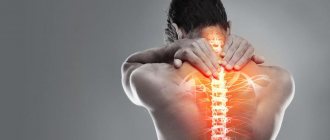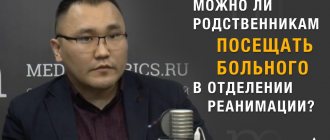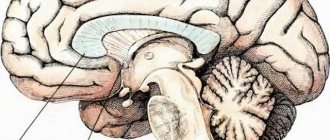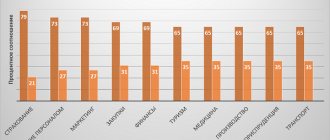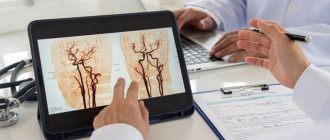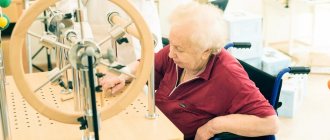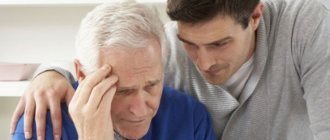June 21, 2021
A hemorrhagic stroke is the result of a spontaneous rupture of a blood vessel in the brain, causing bleeding into nearby brain structures.
According to statistics, 20% of strokes are hemorrhagic. With this type of stroke, symptoms will be determined by the specific area of the brain where the bleeding occurs and what that area controls.
In this article we will tell you how hemorrhagic stroke occurs, its types, treatment and life after a stroke.
What is hemorrhagic stroke
A hemorrhagic stroke occurs when blood comes out of a ruptured vessel under high pressure, pushes brain tissue apart, forming a hematoma (blood clot), and soaks an area of the brain with blood.
If the doctor diagnoses a hemorrhagic stroke, then treatment will be aimed at stopping the bleeding, removing a blood clot (hematoma), combating cerebral edema and other possible serious complications.
Risk factors for hemorrhagic stroke
The causes of hemorrhagic stroke may be as follows: in 50% of cases, hemorrhagic stroke occurs due to a rupture of a vessel at the site of an atherosclerotic plaque with a significant increase in blood pressure. Other causes may be pathologically altered walls of intracerebral arteries, a tumor, taking medications that increase blood flow, as well as rare diseases.
Risk factors for hemorrhagic stroke may include:
Hypertension
If a person suffers from hypertension - high blood pressure, then weak blood vessels cannot withstand high pressure and burst.
Aneurysm
This is a pathological local expansion of the lumen of the cerebral artery. The vessel gradually expands, becomes larger and larger, its walls become thinner, which leads to rupture of the aneurysm.
Brain arteriovenous malformations (AVMs)
Another congenital pathology. An AVM is a tangle of abnormal arteries and veins without capillaries between them. Such vessels have a much thinner wall than healthy ones, so it is highly likely that they can rupture.
Head injury
Skull fractures and penetrating injuries can damage the artery and cause bleeding.
Disorders in the blood coagulation system
Hemophilia, sickle cell anemia, DIC syndrome, thrombocytopenia.
Richly supplied tumors
Such as angiomas and metastatic tumors can bleed into brain tissue.
Amyloid angiopathy
Accumulation of protein in artery walls.
Types of hemorrhagic stroke
Hemorrhagic stroke is characterized by a more severe course than ischemic stroke, with a predominance of cerebral symptoms - impaired consciousness, severe headache, dizziness, vomiting, convulsions.
Hemorrhagic strokes are divided into two types—parenchymal and subarachnoid.
Parenchymal stroke
This type of stroke occurs when there is bleeding into the brain parenchyma due to the rupture of a blood vessel inside the brain.
Cause
The cause of the rupture may be high blood pressure, aging blood vessels, or arteriovenous malformation (a tangle of misshapen blood vessels).
Clinical picture
Before a parenchymal stroke, blood pressure often rises and is preceded by strong psycho-emotional and/or physical tension and stress. During the “impact,” the person loses consciousness, the face becomes purple, and the breathing becomes hoarse, the pupils do not react to light, and paralysis is observed.
Subarachnoid hemorrhage
This type of stroke occurs due to a rupture, such as an aneurysm, resulting in bleeding into the subarachnoid space of the brain.
Cause
The cause of rupture in 80% of cases is a vascular aneurysm. This disease can be congenital or develop during life, especially if a person has a hereditary predisposition to it.
Clinical picture
The most common symptom is a sudden, explosive headache, which is described as the worst headache ever or as if it were a blow to the head. This may only last a few seconds or even a fraction of a second.
A disturbance of consciousness occurs, and the person becomes lethargic and drowsy. There are meningeal symptoms - nausea, vomiting, convulsions and fear of light, but there are no neurological symptoms - paralysis.
Consequences of a massive stroke on the right side of the hemisphere
With an ischemic stroke on the left side of the brain, speech is immediately impaired, so patients immediately call an ambulance.
Whereas with a right-sided stroke, with less pronounced symptoms, time is lost (it is advisable to provide medical assistance within the first 3 hours), as a result, many vital brain cells die. The consequences will be:
- Memory problems or even complete loss;
- Violation of worldview and sensations bordering on insanity. For example, the patient may have the feeling that the arms or legs are not his, or, on the contrary, he is the owner of a large number of paralyzed limbs;
- The patient may not understand what people are telling him, it is difficult for him to estimate the size of an object, the distance to it, or dress incorrectly;
- Most suffer from depression and indifference to others.
First aid for hemorrhagic stroke
Having identified the symptoms of a stroke in a person who is next to you, try not to panic and use the following algorithm:
- assess your general health: breathing, level of consciousness, heart rate, blood pressure;
- identify obvious signs of a stroke (read about the FAST test below);
- call an ambulance;
- try to find out the circumstances of the deterioration in health if the patient is able to communicate;
- place the person correctly - on his side, bending his upper leg at the knee;
- take care to create conditions in which sufficient oxygen will be supplied;
- Monitor the patient’s condition until medical workers arrive and arrange for his transportation to the nearest hospital.
FAST test
It explains the obvious signs of a stroke and helps to quickly understand that a person has had a “stroke”:
Face
The face becomes weak or sagging, the effect is usually more noticeable on one side.
Arm
One arm becomes numb or weak, and it may be difficult to lift it.
Speech
It becomes difficult to speak, and the victim's voice becomes slurred.
Time to call (Time)
If any of the above are noticed, you should immediately call emergency services.
In addition, hemorrhagic stroke is characterized by:
- weakness, loss of sensation in the arm, leg, most often on one side of the body;
- decrease or loss of vision;
- loss of speech and inability to understand someone else’s speech;
- Strong headache;
- loss of orientation and perception, loss of balance.
Symptoms
The signs of the onset of an illness are beyond doubt; not only doctors, but also ordinary people should know them in order to help their loved ones, acquaintances, or just a person on the street who has become ill in time. You should call the emergency room immediately if you experience the following symptoms:
- Sudden loss of speech (or when it becomes slurred);
- Inability to move an arm or leg;
- Inability to smile (the right side of the mouth sags);
- drooping eyelid;
- State of stupefaction, spatial and temporal disorientation, the patient complains of “mess in the head”;
- Severe headache with vomiting, dizziness;
- The extended right leg turns the foot inward;
- The right arm is bent and pressed towards the body.
Hospitalization - treatment of hemorrhagic stroke
After a person is hospitalized with a suspected stroke, doctors will conduct an examination and choose a treatment strategy based on the severity of the patient's condition and the type of stroke.
Basic therapy includes:
- ensuring the function of external respiration - oxygen transfer or transfer to mechanical ventilation;
- conducting thrombolytic therapy;
- reduction of cerebral edema;
- correction of elevated body temperature;
- correction of impaired metabolic parameters;
- carrying out anticonvulsant therapy, stopping vomiting;
- surgical intervention - according to indications.
Consequences of a right-sided stroke
Any type of stroke is characterized by rapid progression and disruption of brain function with the death of nerve cells. The severity of clinical manifestations is influenced by:
- The period during which adequate medical care was provided.
- Quality of treatment and rehabilitation.
- Type of stroke.
- Location and size of the lesion.
Extensive strokes lead to motor disorders and decreased muscle tone due to damage to a significant number of neurons. A right-sided stroke is characterized by the appearance of left-sided hemiparesis - a violation of muscle tone and sensitivity (tactile, temperature, pain and muscle-articular).
Depending on the location of the pathology, the manifestations of a stroke on the right side will be as follows:
- The region of the central convolutions of the brain. The motor center is located here, so the patient can expect the development of paresis (partial impairment of the movement of the left limb or the entire half of the body) or complete paralysis.
- Parietal region. Responsible for the sensitivity of nerve endings. The result of its damage is a decrease in sensitivity to pain, cold, and heat on the left side of the body.
A right-sided stroke always causes disturbances:
- Spatial perception - it is difficult for the patient to assess the size and shape of objects, which affects the control of his own body.
- Perception of time.
- Loss of vision of the left half of space - vision refuses to perceive signals from the left side.
A big problem with right-sided stroke is anagnosia, which is expressed in a passive reaction to any restorative procedures: massage, reflexology, etc., and therefore the recovery of motor functions slows down.
Neuropsychopathological syndromes with extensive right-sided stroke in the parietotemporal region:
- Constructive-spatial apragnosia.
- Impaired perception of one's own limbs.
- Changes in the emotional state: depression, carelessness, inadequate reaction during communication - foolishness, tactlessness, swagger.
After a right-sided stroke, some patients experience hyperactivity in combination with an inadequate assessment of reality. The patient does not understand what is happening to him, cannot assess the extent of the pathology and his capabilities, etc.
Side effects of stroke in the right and left hemisphere
The severity of symptoms of a hemorrhagic stroke depends on which parts of the brain are affected. Each half of the brain controls the opposite side of the body. Thus, a stroke to the right side of the brain results in damage to the left side of the body.
Consequences if a hemorrhagic stroke occurs - right side:
- left-sided weakness or paralysis, sensory impairment;
- vision problems, including inability to see in the left visual field of each eye;
- spatial problems with perceiving directions, such as up or down, forward or backward;
- inability to recognize body parts;
- inability to find objects such as clothing or toiletries;
- memory problems;
- behavioral changes such as lack of concern for situations, impulsivity, tearfulness and depression.
Consequences if a hemorrhagic stroke occurs - left side:
- right-sided weakness or paralysis, sensory impairment;
- problems with speaking and understanding language (aphasia);
- vision problems, including inability to see the correct field of vision in each eye;
- impairment of the ability to count, reason and analyze objects;
- behavioral changes such as depression, caution, and indecisiveness;
- impairment of the ability to read, write and learn new information;
- memory problems.
Extensive right hemisphere stroke
Damage to the right hemisphere of the brain is characterized by sudden blockage of large vessels, and the disease occurs quickly and progresses at lightning speed.
Symptoms have the maximum severity: sudden loss of consciousness, partial or complete loss of coordination of movements, severe headache, vomiting, dizziness. A person loses orientation in space, the functions of the parts of the brain responsible for perceiving the speed of movement and shapes of objects are sharply disrupted, and paralysis of the left side of the body occurs.
Often people who have managed to survive such a cerebrovascular accident will later be prone to depression and individuals with pronounced mental passivity.
Patients suffering from diabetes mellitus and hypertension are most susceptible to stroke. Often victims of brain stroke will be children and adolescents with congenital vascular disorders.
Typically, the onset of the disease is accompanied by minor ischemic attacks, or so-called small strokes, sometimes asymptomatically.
Timely hospitalization can guarantee a favorable outcome with minor neurological disorders, in rare cases even a complete restoration of all the body’s capabilities, but a second blow can cancel everything out - the process will be more acute, the size of the affected area will be larger.
Since ancient times, the brain has been organized in a highly efficient manner, with responsibilities divided between the two hemispheres. The left side is responsible for logic, and the right side is responsible for dreams and fantasies.
With an extensive stroke of the right hemisphere of the brain, the following picture will be observed:
- Partial memory impairment. Speech, which is controlled by the left hemisphere, may be normal. Diagnosing the problem can be very difficult;
- Numbness and paralysis of the body will affect the left side;
- The facial muscles of the face will be paralyzed and devoid of sensation on the left side;
- The patient's mood will be accompanied by lethargy and depression.
Prevention and treatment of complications
Stroke patients are susceptible to many complications. These people typically have underlying medical conditions such as hypertension, diabetes, heart disease, or other illnesses that increase the risk of systemic medical complications during stroke recovery.
However, some complications may occur as a direct consequence of the brain injury itself, immobility, or stroke-related treatment. These events significantly impact the final outcome of stroke patients and often impede neurological recovery.
Brain swelling
Swelling or inflammation is part of the body's natural response to injury. Edema refers to swelling due to accumulated fluid. However, if swelling occurs in the brain, it can cause serious complications. Brain swelling can restrict blood supply to the brain, causing brain tissue to die.
Treatment:
- decrease in body temperature;
- elevation of the head position;
- relief of pain and cramps;
- sometimes a surgical operation in which part of the cranial bone is removed to avoid compression of the nerve tissue.
Inflammatory processes in the lungs
Pneumonia is one of the common complications of stroke. In the case of a stroke, problems swallowing can cause aspiration, the entry of food or liquid into the airways, which can lead to pneumonia. Therefore, working with a speech therapist and breathing exercises are the main methods of preventing inflammation in the lungs.
Treatment:
- Therapy is prescribed - antibiotics and other medications.
Urinary tract inflammation and urinary incontinence
After a stroke, the patient may experience problems with urination in the form of urinary retention or incontinence.
Treatment:
- antibiotics;
- anticholinergic drugs such as oxybutynin chloride, which are used to reduce urges and frequency;
- an external catheter (uro-sheath) in men or diapers in women;
- use of catheters.
Thrombosis
If blood moves through the veins too slowly, a blood clot can form in the blood vessels. A case of thrombosis can become life-threatening if the clot breaks off and travels to a vital organ.
Thrombosis can occur from 2 weeks after a stroke due to prolonged immobility, previous surgery and other chronic diseases.
Treatment:
- exercise therapy;
- using elastic bandages or elastic stockings;
- antithrombotic therapy.
Stiffness in the joints
Due to forced immobility after a stroke, contractures may occur in the joints. Contracture is a loss of mobility over time due to abnormal shortening of soft tissue structures covering one or more joints. These include skin, ligaments, tendons, muscles and joint capsules.
Prevention:
- physiotherapy;
- massage.
Drug treatment of right-sided stroke
Ischemic stroke has the second name “cerebral infarction”; it affects both hemispheres: left and right. But, as scientists have established, a right-sided cerebral infarction has less severe consequences than a left-sided one, and after it a full recovery is possible. But its rapid diagnosis is difficult due to the primary symptoms.
For example, speech is not impaired, which can confuse others.
But there is paralysis of the facial muscles, limbs on the left side of the body, problems with hearing, vision, and smell. If the patient is left-handed, his speech may still be impaired. With a large area of brain damage, severe headaches, vomiting, nausea, loss of consciousness, and lack of motor functions appear.
The lack of quick, correct recognition leads to loss of time to provide assistance and worsens the prognosis for a successful outcome.
Therapy (basic, specific) for right-sided cerebral infarction is the same as for left-sided one.
Basic treatment involves the following activities:
- Support of breathing, basic physiological functions of the body, heart function;
- Normalization of blood pressure, control over it;
- Control over normal body temperature;
- Prevention of bedsores, complications such as pneumonia, deep vein thrombosis of the extremities;
- Symptomatic therapy that eliminates tachycardia, convulsions, arrhythmia, vomiting and other symptoms;
- Prevention of cerebral edema.
Specific therapy is associated with the following actions:
- By administering thrombolytics (intravenously), which can remove a blood clot blocking a vessel and obstructing blood flow. The area of damage in the brain shrinks, increasing the chance of a successful outcome.
- The use of blood thinning drugs that can prevent the recurrence of a blood clot.
- Carrying out neuroprotection with drugs that protect living neurons from death.
It is possible that doctors may decide to perform surgery to reduce symptoms. But even if the patient managed to recover from a stroke, treatment for its consequences will continue throughout his life.
Statistics on survival after hemorrhagic stroke
The World Health Organization annually analyzes how many people live after a hemorrhagic stroke, the consequences that affect human health and the possibilities of rehabilitation.
The prognosis for survival after hemorrhagic stroke is lower than for ischemic stroke.
According to WHO, the five-year survival rate after hemorrhagic stroke is 26.7%. Long-term survival prognosis is significantly better in younger patients without hypertension, alcoholism, or diabetes.
Probability of survival after hemorrhagic
and ischemic stroke - comparative statistics.
| Time after stroke | Hemorrhagic stroke | Ischemic stroke |
| 6 months | 36% | 81% |
| 1 year | 34% | 76% |
| 2 years | 31% | 68% |
| 3 years | 27% | 61% |
Source : Time Trends in Survival Following First Hemorrhagic or Ischemic Stroke Between 1991 and 2015 in the Rotterdam Study Reem Waziry, Alis Heshmatollah, Daniel Bos, Lori B. Chibnik, M. Arfan Ikram, Albert Hofman, M. Kamran Ikram
Life after a stroke - rehabilitation and prevention of recurrent stroke
For a person who has suffered a hemorrhagic stroke, treatment and rehabilitation are vital. A range of treatments can help people cope with the different effects of a stroke, including the specific physical, mental, social and emotional problems they may face. This may include relearning skills, adapting to changes, and rethinking your life.
Today, for the sake of effective rehabilitation, it is not necessary to go to a special medical center or sanatorium; recovery can be done on an outpatient basis and at home, without compromising the quality of rehabilitation, but, on the contrary, more effectively, because a person is in a familiar and comfortable place, close to loved ones. Read more about how comprehensive rehabilitation at home works here:
Stages of rehabilitation
Recovery after a hemorrhagic stroke will depend on which functions are impaired and the severity of the impairment. Functional changes after a stroke will depend on which part of the brain was damaged and how severely.
Rehabilitation objectives:
- maximum restoration of motor and speech functions;
- physical and psychological adaptation of a person to changed living conditions.
Each patient recovers differently from a hemorrhagic stroke. This depends on the volume of brain cells affected, age, chronic diseases and other factors. Recovery after a stroke is divided into several periods:
- early stage - thanks to early rehabilitation in the hospital, it is possible to significantly improve the restoration of lost functions;
- stage after discharge - the patient continues to restore lost functions on an outpatient basis or at home.
How long do people live after a right-sided blow?
On average, up to 5-6% of people with cerebral ischemia die within 1 month (with hemorrhage - within 14-15 days). Up to 9-10% of victims do not live to see 1 year, and almost half – to 5 years after the attack. Only 20-22% of patients have a chance to live up to 7 years. Longer survival is observed only in every tenth person who has had a stroke, with 70-75% of them losing ability to work, and up to 20% losing self-care.
Right-sided stroke is rightly considered a very serious pathology. In this direction, one piece of advice suggests itself - to prevent it, it is necessary to follow basic preventive measures.
If you have chronic diseases of the cardiovascular system, hypertension and blood problems, it is necessary to give up bad habits and ensure a balanced diet. The optimal combination of an active lifestyle and sports with good rest is reliable protection against stroke.

